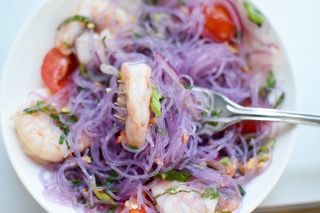
Color-changing foods are the latest trend in "eating for the insta" instead of, you know, eating. UK-based tea company Yumchaa sells a "Blue Voodoo" blend that morphs into purple when served with a lemon slice. In New York, Thai food fans will get the same effect when ordering the Magic Noodle Salad at Thaimee, a restaurant located in Brooklyn's McCarren Hotel. Time Out New York reports that the dish resulted from executive chef Hong Thaimee's experimenting with using pea flowers.
Related: Charcoal food trend sweeping U.S.: Looks good on Instagram but is bad for your health
Restaurant general manager Matt Bruck tells Newsweek that standard vermicelli noodles, commonly found in Thailand are used. After they are soaked in pea flowers, servers pour fresh lime juice over the dish, noting that "Customers sometimes squeeze too much, making the color nice but the noodles too acidic to eat." A similar process is used to make eye-catching dumplings, too. Bruck says that pea flowers also brighten up drinks. Cocktails around the world have been sporting what has been dubbed a magical ingredient.
There are no spells or witchcraft behind the color-changing noodles, just some very basic science. Gregory Ziegler, food scientist at Penn State University, says that the power lies in the combination of citrus and pigments known as anthocyanins, commonly found in fruits and vegetables. Ziegler explains that the transformation is a result of a change in the pH, which gauges acidity, of the food item. As many flower petals also contain anthocyanins, this is a popular ingredient for color-changing food items. Mixing lime juice, or any other food with high acidity, will change the color, typically from blue to red, though how high the acidity is helps determine the end result.
For those who want to try this out at home, Ziegler says it's relatively simple. He recommends starting with any anthocyanin-containing food, like blueberries, and changing its acidity level by combining with a food lower on the pH scale. Adding more acid will result in a more dramatic color change. Dinner parties can be livened up with color-changing cocktails that use the flower petals and egg whites, he advises. And sometimes, the mundane can be brightened up with this trick, too. "When I wash out a glass that has had red wine in it, the water turns blue since the water in my area is alkaline," Ziegler says.
But it's not all just about aesthetics. It turns out this social media trend could actually be healthier. Researchers at the University of California Los Angeles have developed food coloring using natural pigments to provide an alternative to artificial dyes, which have been linked to behavioral problems in children.
Uncommon Knowledge
Newsweek is committed to challenging conventional wisdom and finding connections in the search for common ground.
Newsweek is committed to challenging conventional wisdom and finding connections in the search for common ground.
About the writer
Melissa is a science writer covering health for Newsweek and has contributed to Inc., Dr. Oz The Good Life, Men's Fitness, Marie Claire and others. She earned ... Read more
To read how Newsweek uses AI as a newsroom tool, Click here.








